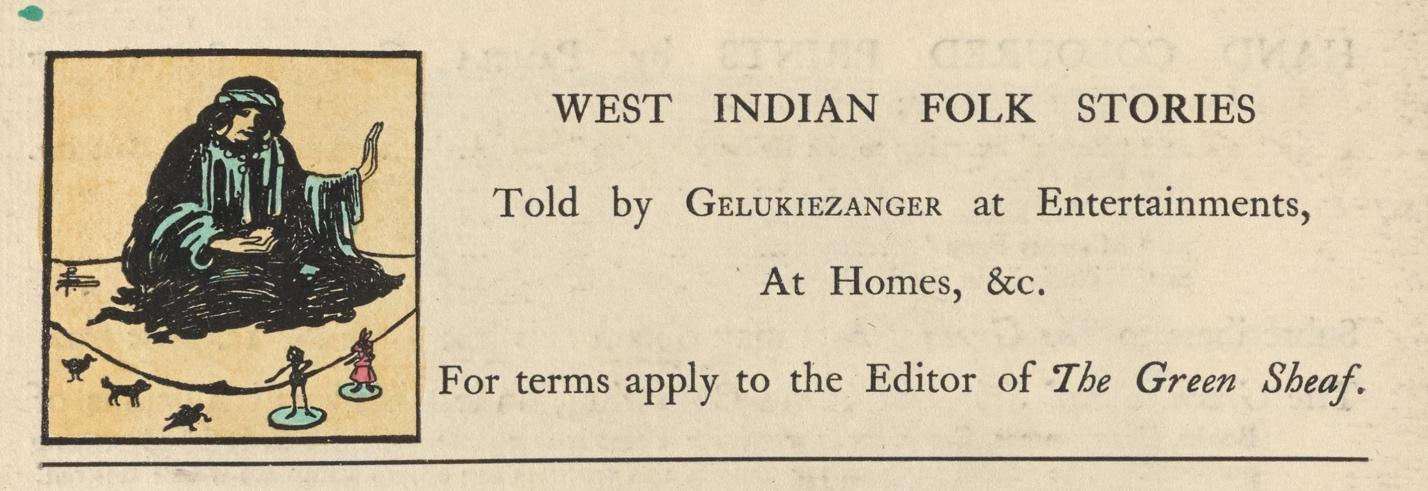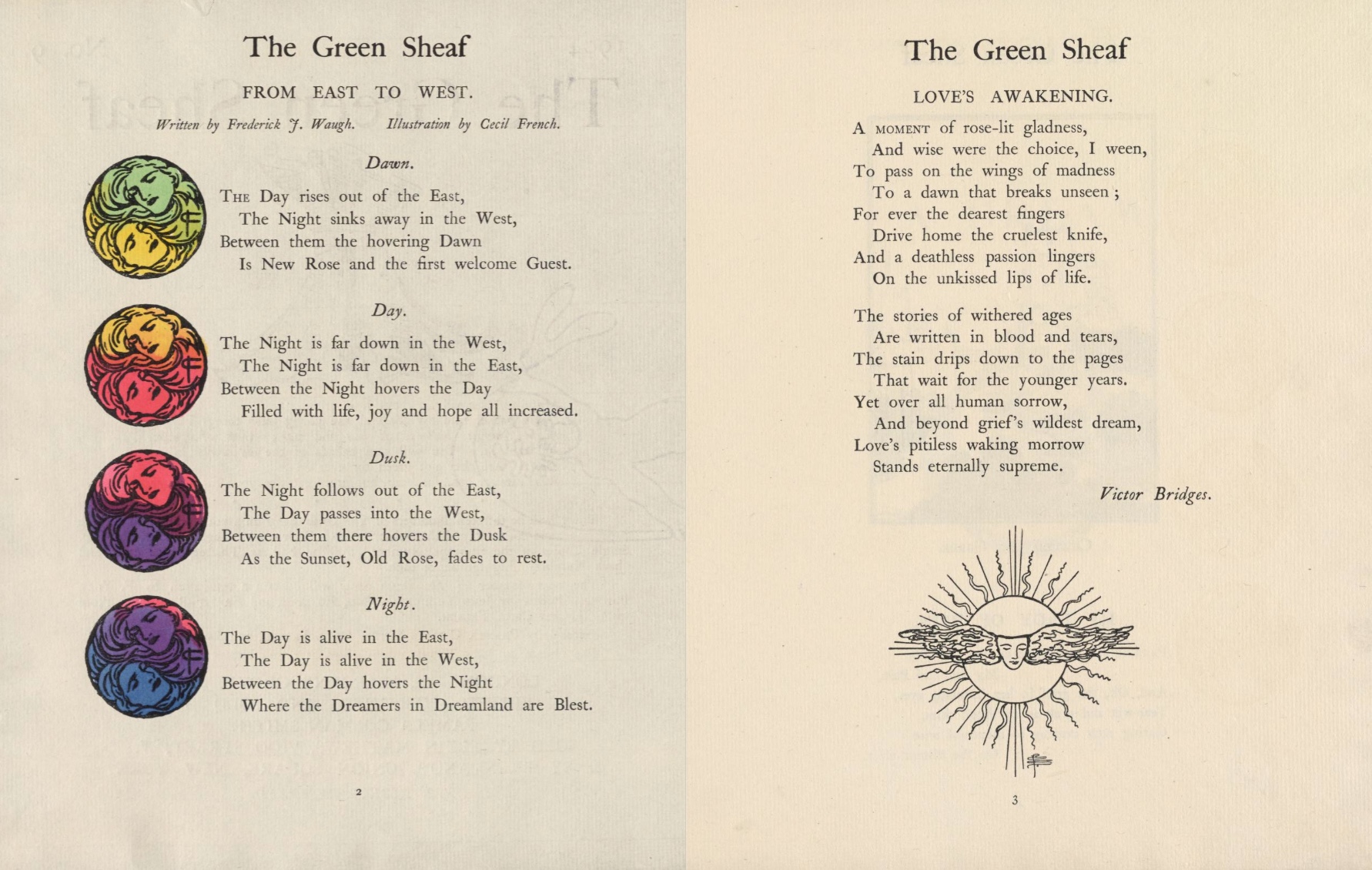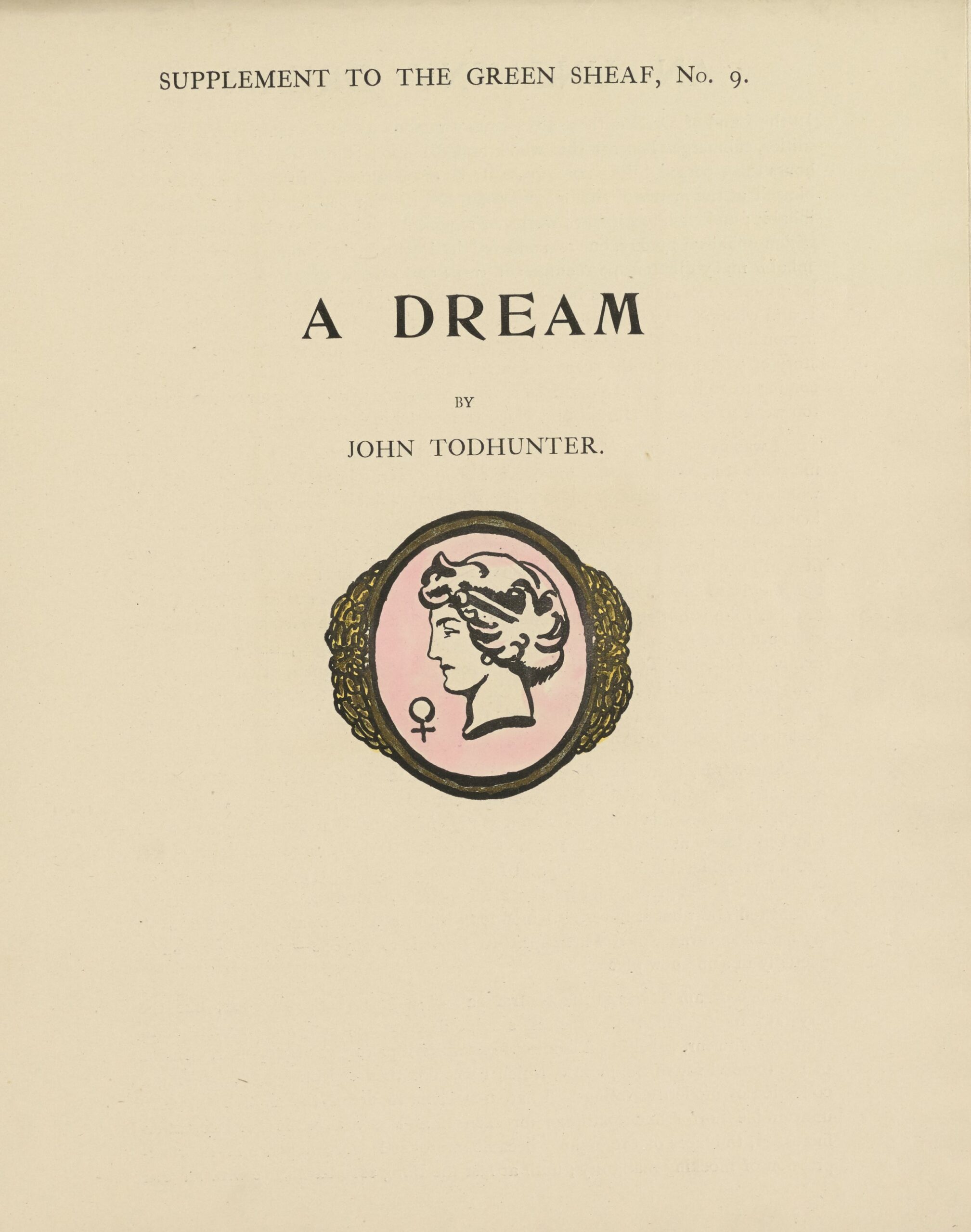XML PDF
Critical Introduction to The Green Sheaf
No. 9, 1904


“I have been flipping through the dandified leaves of the ninth number of that strange little periodical ‘The Green Sheaf,’ published and edited and sold by the strange personality whom we call Pamela Colman Smith,” the critic for The Academy and Literature wrote in winter 1904 (Rev.). In this rare notice of The Green Sheaf, the reviewer appears to equate the idiosyncratic character, small size, and flamboyant appearance of the magazine with that of its editor-publisher, who was then making a name for herself performing West Indian folk tales in the colourful character of Gelukiezanger at London parties. Smith (1878-1951) had advertised these “for hire” performances in her magazine’s sixth number with an illustration showing her seated on the floor swathed in exotic robes (fig. 1). By using the term “dandified,” the critic seems to suggest that both Smith’s storytelling garb and the pages of her hand-coloured magazine appear self-conscious and overly elaborate. Despite these personal remarks, however, the critic goes on to acknowledge the Smith’s artistic power: “some of the designs, by far the best, are from her own whimsical hands” (ibid.).
Smith uses a colour palette of blue/purple and red/orange chroma offset by earth tones of green and brown to illuminate a border decoration by Cecil French (1879-1953) and one of her own illustrations; she also decorates the title page of the Supplement with a pink-tinted ornament (fig. 2). The number’s three remaining images—two by Smith and one by W. T. Horton (1864-1919)—are black-and-white line drawings. The paucity of hand-coloured images, coupled with a relatively meagre array of literary contents across the issue’s eight pages, suggests that Smith may have had difficulty putting together the first Green Sheaf of the new year. In addition to its six images, the number includes a scant three poems and two prose pieces. The four-page Supplement features “A Dream” by John Todhunter (1839-1916), which had been promised as forthcoming throughout the magazine’s fall issues. Dreams and the symbolism of the sun’s movement from east to west direct the issue’s thematic concerns.

Smith establishes the issue’s themes in the magazine’s first opening, which features “From East to West” by the American marine artist Frederick W. Waugh (1861-1940) on the verso and “Love’s Awakening” by English author Victor Bridges (1878-1972) on the recto (fig. 3). Waugh’s four-quatrain lyric follows the diurnal movement of the sun from Dawn through Day, Dusk, and Night, “Where the Dreamers in Dreamland are Blest” (2). French ornaments each quatrain with a symbolic image of two sleeping dreamers, whose faces change in colouration as the day progresses to night. Bridge’s poem similarly evokes the tropes of dawn and dreaming and concludes with an image of the eternal realm beyond life’s vicissitudes. Smith underscores the lyric’s symbolism by punctuating it with an occult image of a winged face over a radiating sun (fig. 3).
Smith gives the magazine’s second page opening to a long narrative poem by Alix Egerton (1870-1932), illustrated by W. T. Horton. Egerton’s “My Lady of Pain” conveys the melancholy stasis of an embowered woman, who sits at twilight “looking west” from “the window-bars of this prison-palace / In the castle tower” (Egerton 5); symbolically, the lady awaits her journey to death. Rather than picturing the imprisoned central figure, Horton’s half-page illustration, entitled “Chateau de Garde,” encapsulates the symbolic landscape of a romantic castle set on a river running out into the sea.
The magazine’s final page opening takes the issue’s themes into the realm of childhood. Smith places her coloured illustration of an untitled excerpt from Lessons for Children (1778) by Anna Barbauld (1743-1825) on the verso and “The Boat of Dreams,” a story by American author and children’s magazine editor Albert Bigelow Paine (1861-1937), on the recto. Smith, who deeply admired Barbauld’s Lessons, had approached numerous publishers about bringing out an illustrated edition when she began her career in London at the turn of the twentieth century (O’Connor 44). After her proposals met with no success, she incorporated some of her Barbauld illustrations into the magazines over which she had editorial control: A Broad Sheet (No. 12, 1902) and The Green Sheaf (Nos. 4, 9, and 13). The Barbauld excerpt she illustrates for The Green Sheaf’s ninth number describes the situation of a woman and three children who are house-bound due to the pouring rain outside. Unlike the vision of death generated in Egerton’s “My Lady of Pain,” however, physical imprisonment in this case results in pleasure: “we will sit by the fire, and read, and tell stories, and look at pictures” (Barbauld 6). Smith’s illustration depicts a woman seated in a comfortable chair with her back to the darkened casement windows; two children look at a picture book with her while a toddler plays with his pull-toy nearby. On the facing page, Paine’s allegorical story picks up on the issue’s interest in symbolic journeys, telling the tale of “two happy children” who play on the banks “of a bright river that came out of the blue sky to the east and flowed into the sky in the west, where evening turned it into a river of gold” (Paine 7). Eventually, the River Boat arrives for the children, bearing them away down the river “to a fair land that lies through the gates of evening, where all our dreams become realities, and all our realities dreams” (ibid.).
Pamela Colman Smith’s interest in symbolic correspondences and alternative realms is evident in the numerous pieces on dreams and dreaming that she published throughout the Green Sheaf’s print run. As Katharine Cockin observes, “In symbolist art of this time the dream or vision was ubiquitous as a means of engaging the spiritual or other dimensions”; dreams appear regularly in the work of those who were attracted to the occult rituals and practices of the Hermetic Order of the Golden Dawn, to which Smith belonged (165). John Todhunter (1839-1916), whose “A Dream” supplied the issue’s Supplement, was, like his friend W.B. Yeats (1865-1939), an Irish member of this Order. Todhunter’s story recounts his otherworldly experiences with what he describes as “serial dreams,” a term that suggests an interesting analogy to the dreams that appear serially across The Green Sheaf’s thirteen numbers. Todhunter claims that in serial dreams, “one may fitfully inhabit many different personalities in turn,” in a variety of visionary realms, until the serial comes to a climax and ceases (Todhunter [ii]). He recounts how he repeatedly encountered, in a variety of locales and circumstances, a fifteenth-century painting of the Crucifixion that appeared to have a life of its own. Like the eponymous hero of Oscar Wilde’s (1854-1900) The Picture of Dorian Gray, Todhunter is mesmerized by this ever-changing painting, which continues to fascinate him in each new encounter, despite its increasing malignity. Just as Wilde’s novel ends with the identification of the dead Dorian by virtue of his signet ring, Todhunter’s serial dream is only put to rest when he throws away a medallion ring he is given by the painter of the picture. Smith draws our attention to the symbolic importance of this ring by representing it on the Supplement’s title page (fig. 4).

Smith uses the final pages of both the issue and its Supplement to advertise her own work as well as that of people in her professional network. The Advertisements at the back of Green Sheaf Number 9 promote the publishing list of Elkin Mathews (1851-1921), who sold issues of Smith’s magazine at his premises in Vigo Street, and the Gallery of John Baillie (1868-1926), who exhibited art by Smith and those in her circle in his Bayswater showroom. As she did in every issue, Smith also offers magazine subscribers the opportunity to buy her hand-coloured prints of actress Ellen Terry (1847-1928) in various roles (Advertisements 8).
The Advertisements on the back page of the Supplement are more innovative and personal than those at the end of the issue. It is here that Smith first signals to the Green Sheaf’s readers that the magazine would not continue as a monthly serial after the thirteenth number, but would convert into a quarterly publication (Advertisements, Supplement [iv]). While this plan was practical and perhaps even feasible, given Smith’s challenges in putting together sufficient contents for a new number each month, it was never enacted: The Green Sheaf did not begin a new series when its thirteen-issue print run concluded in late spring of 1904. Smith also uses the Supplement to aim an immediate appeal to subscribers. Its advertising page enticingly offers Smith’s “Portrait of W.B. Yeats” in two forms: a signed proof on India paper (limited to 50 proofs) for fifteen shillings; and a photogravure print for two shillings sixpence (Advertisements, Supplement [iv]). As the reviewer for the Academy and Literature noted, this was an unashamed appeal to prospective buyers; the souvenir was sure to be “sought after by admirers of the Irish poet” (Rev.) on both sides of the Atlantic.
![Figure 5. Pamela Colman Smith, illustrated advertisement, Supplement to The Green Sheaf, No. 9, 1904 [iv].](https://1890s.ca/wp-content/uploads/GSV9-colman-smith-supplement-illustration.jpg)
The Supplement’s advertising page is headed by a large illustrated ad for home-made sweets by a Miss Alice Quin, who was based in London (fig. 5). This promotion of local perishables stands out from other Green Sheaf advertisements, which typically feature goods and services offered by those in Smith’s professional network of workers in print, performance, and arts-and-crafts, many of whom were women (Grant, par. 13). Notably, this is one of only five illustrated advertisements Smith produced for her magazine. The others advertise the costume shop of her friend and collaborator Edith Craig (Nos. 1-5) and Smith’s own art-related labour: her performances of West Indian folktales (No. 6), her School of Hand-Colouring (No. 7), and her Green Sheaf shop in Knightsbridge (No. 13). It seems likely that Smith had a personal connection with Alice Quin, perhaps through her sister Isobel, who shared her address at 29 St. Stephen’s Mansions. Isobel’s services as a frame-maker were patronized by Green Sheaf contributors Alix Egerton, Pamela Colman Smith, and Ellen Terry, among others, according to an advertisement printed in the magazine’s twelfth number (Advertisements, Green Sheaf No. 12, 8). Smith’s illustrated ad for Alice Quin depicts a couple looking at a shop whose goods appear to entice the young woman; the composition invites readers to imagine that these might be the “delicious…sweets” described in the advertisement (fig. 5). However, those readers familiar with English folk songs would have recognized that the unattributed verses printed below the image—“I never could refuse her, / Whatever she’d a mind to”— derive from a popular song about an English costermonger whose beloved is transported to Australia for theft. Smith published this song, titled “All Around my Hat I will wear a Green Willow,” in A Broad Sheet, the magazine she co-edited with Jack Yeats (1871-1957), where it was accompanied by a coloured version of the line drawing she later recycled for the Alice Quin advertisement. The song was a favourite with Smith, who included it in her performance repertoire. In February 1908, a reviewer reported that Smith sang the ballad “in the true folk-song manner” at a performance she gave at John Baillie’s Art Gallery, where she also told Jamaican folk stories in her role as “Gelukiezanger” (“Miss Smith’s Story-Telling”).
For the transnational Smith, oral culture’s folk tales, ballads, and songs had the capacity to reach beyond the regional to express, in symbolic form, shared human emotions and experiences. In The Green Sheaf’s final issues of 1904, Smith gradually moved the magazine from its original association with the Irish Revival movement to a broader celebration of local-colour literature and symbolist representations.
©2022 Lorraine Janzen Kooistra, FRSC, Emerita Professor of English and Senior Research Fellow, Centre for Digital Humanities, Toronto Metropolitan University
Works Cited
- Advertisements. The Green Sheaf, No. 9, 1904,
p. 8. Green Sheaf Digital Edition, edited by
Lorraine Janzen Kooistra, Yellow Nineties 2.0,
Toronto Metropolitan University Centre for Digital Humanities, 2022.
https://1890s.ca/GSV9-ads/
- Advertisements. The Green Sheaf, No. 12, 1904,
p. 8. Green Sheaf Digital Edition, edited by
Lorraine Janzen Kooistra, Yellow Nineties 2.0,
Toronto Metropolitan University Centre for Digital Humanities, 2022.
[url]https://1890s.ca/GSV12-ads/
- Advertisements. Supplement (p. iv) to The Green Sheaf, No. 9, 1904. Green Sheaf Digital Edition, edited by Lorraine Janzen Kooistra,
Yellow Nineties 2.0, Toronto Metropolitan
University Centre for Digital Humanities, 2022.
https://1890s.ca/GSV9-supplement-ads/
- Barbauld, Anna. Untitled [“The sky is very black”], illustrated by Pamela
Colman Smith. The Green Sheaf, No. 9, 1904, p. 6.
Green Sheaf Digital Edition, edited by
Lorraine Janzen Kooistra, Yellow Nineties 2.0,
Toronto Metropolitan University Centre for Digital Humanities, 2022.
https://1890s.ca/GSV9-barbauld-the-sky/
- Bridges, Victor. “Love’s Awakening,” illustrated by Pamela Colman Smith.
The Green Sheaf, No. 9, 1904, p. 3. Green Sheaf Digital Edition, edited by Lorraine
Janzen Kooistra, Yellow Nineties 2.0, Toronto
Metropolitan University Centre for Digital Humanities, 2022.
https://1890s.ca/GSV9-bridges-love/
- Cockin, Katharine. “Bram Stoker, Ellen Terry, Pamela Colman Smith and the Art of Devilry.” Bram Stoker and The Gothic: Formations to Transformations, edited by Catherine Wynne, Palgrave Macmillan, 2016, pp. 159-171.
- Egerton, Alix. “My Lady of Pain,” illustrated by W. T. Horton. The Green Sheaf, No. 9, 1904, pp. 4-5. Green Sheaf Digital Edition, edited by Lorraine
Janzen Kooistra, Yellow Nineties 2.0, Toronto
Metropolitan University Centre for Digital Humanities, 2022.
https://1890s.ca/GSV9-egerton-lady/
- Grant, Marion. “Advertising Women’s Entrepreneurship in The Green Sheaf: Pamela Colman Smith and the
Fin-de-Siècle Marketplace.” Nineteenth-Century Gender
Studies, Special Issue on “Women and Other ‘Undesirables’: Female
Creative and Technical Labor in Nineteenth-Century Print Culture,” edited by
Jocelyn Hargrave and Megan Peiser, vol. 18, no. 2, Summer 2022, 22 pp.
http://ncgsjournal.com/issue182/index.html
- Horton, W. T. “Chateau de Garde.” Illustration for “My Lady of Pain,” by
Alix Egerton. The Green Sheaf, No. 9, 1904, p. 4.
Green Sheaf Digital Edition, edited by
Lorraine Janzen Kooistra, Yellow Nineties 2.0,
Toronto Metropolitan University Centre for Digital Humanities, 2022.
https://1890s.ca/GSV9-horton-chateau/
- “Miss Colman-Smith’s Story-Telling,” The Times (London), February 4, 1908. In Stuart Kaplan et al, Pamela Colman Smith: The Untold Story. U.S. Games Systems, 2018, p. 284.
- O’Connor, Elizabeth Foley. “Pamela’s Life.” Pamela Colman Smith: The Untold Story, by Stuart R. Kaplan with Mary K. Greer, Elizabeth Foley O’Connor, and Melinda Boyd Parsons, U.S. Games, 2018, pp. 11-99.
- Paine, Albert Bigelow. “The Boat of Dreams.” The Green
Sheaf, No. 9, 1904, p. 7. Green Sheaf Digital
Edition, edited by Lorraine Janzen Kooistra, Yellow Nineties 2.0, Toronto Metropolitan University Centre for
Digital Humanities, 2022.
https://1890s.ca/GSV9-bigelow-paine-boat/
- Rev. of The Green Sheaf, No. 9. The Academy and Literature, 19 March 1904, p. 307.
- Smith, Pamela Colman. Illustrated Advertisement for Delicious Sweets, by
Miss Alice Quin. Supplement to The Green Sheaf, No. 9, 1904, [iv]. Green Sheaf Digital Edition, edited by Lorraine
Janzen Kooistra, Yellow Nineties 2.0, Toronto
Metropolitan University Centre for Digital Humanities, 2022.
https://1890s.ca/GSV9-supplement-ads/
- —. Illustrated Advertisement for West Indian Folk Stories Told by
Gelukiezanger. The Green Sheaf, No. 6, 1903, p.
16. Green Sheaf Digital Edition, edited by
Lorraine Janzen Kooistra, Yellow Nineties 2.0,
Toronto Metropolitan University Centre for Digital Humanities, 2022.
https://1890s.ca/GSV6-smith-folk-ad/
- —. Illustration for “All Around my Hat, I will wear a Green Willow.” A Broad Sheet, No. 4, April 1902.
- Smith, Pamela Colman. Illustration for Untitled. [“The sky is very
black”], by Anna Barbauld. The Green Sheaf, No.
9, 1904, p. 6. Green Sheaf Digital Edition,
edited by Lorraine Janzen Kooistra, Yellow Nineties
2.0, Toronto Metropolitan University Centre for Digital
Humanities, 2022.
https://1890s.ca/GSV9-smith-the-sky/
- Todhunter, John. “A Dream.” Supplement to The Green Sheaf, No. 9, 1904, pp. [i-iv]. Green Sheaf Digital Edition, edited by Lorraine
Janzen Kooistra, Yellow Nineties 2.0, Toronto
Metropolitan University Centre for Digital Humanities, 2022.
https://1890s.ca/GSV9-supplement/
- Waugh, Frederick J. “From East to West,” illustrated by Cecil French.
The Green Sheaf, No. 9, 1904, p. 2. Green Sheaf Digital Edition, edited by Lorraine
Janzen Kooistra, Yellow Nineties 2.0, Toronto
Metropolitan University Centre for Digital Humanities, 2022.
https://1890s.ca/GSV9-frederick-east-west/
MLA citation: Kooistra, Lorraine Janzen. “Critical Introduction to The Green Sheaf No. 9, 1904.” Green Sheaf Digital Edition, Yellow Nineties 2.0, edited by
Lorraine Janzen Kooistra, Toronto Metropolitan University Centre for Digital Humanities,
2023. https://1890s.ca/gsv9_introduction/.